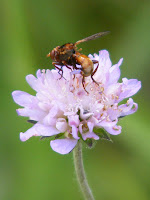The Conopidae are a small family of odd looking flies. There are about 85 species in Europe and they range in size from a tiny 3 mm long to 20 mm, which is large for a fly. They are often black and yellow, or red brown, with long hinged mouthparts and pale faces. They are parasitoids of bumblebees and you sometimes see them lurking about near foraging bumblebees, ready to take their opportunity to inject an egg into the bee's abdomen. They do this while locked together in flight. However, adult Conopids are more often seen merely nectaring at flowers. Those species with particularly long tongues like flowers such as in the Mint Lamiaceae family. They like warm dry areas where there are flowers and flowering shrubs.
Mark van Veen has produced an illustrated key for the species of northwest Europe to help you identify any specimens you may observe and have managed to get good photos of. By far the most commonly encountered species is Sicus ferrugineus.
Sicus ferrugineus:
To work your way through the key, look for an arista (the bristle on the tip of the antennae) that comes off to the side, and ideally you need to be able to see the wing venation. Sicus spp have a twice hinged proboscis (one hinge near the mouth and another in the middle, so it folds in half). They also have short faces ie the cheek is less than half as long as the eye. Sicus spp are fairly large reddish brown flies, 8 - 10 mm long. The base of the wings is whitish and the middle of the wings darkened. S. ferrugineus has brown feet. They are common on the edges of forests or along roadsides in herbaceous vegetation. Don't confuse with Myopa spp, which have much longer faces. The photo below shows a female nectaring on Field Scabious Knautia arvensis at La Croix Sourd near Chaumussay, June. You can see the hinged proboscis behind the front leg (looking like another leg).

Thecophora atra:
This is a small species (5 - 7 mm), rather grey, with a white face. Mark van Veen notes that they are not often seen in the field, but both we, at La Forge (between Preuilly-sur-Claise and Chaumussay), Indre et Loire, France and Chris Raper at Hartslock Nature Reserve,Oxfordshire, England observed them in May 2011 (pers. comm. from CR). 'Ours' were on Short-spurred Fragrant Orchids Gymnadenia odoratissima (photos below). The flies are probably not the orchids' principal pollinator, but their long tongues give them access to the nectar in the spur ('short' is a relative term when referring to the length of G. odoratissima's spur).


References and Further Reading:
Insects of Britain and Western Europe by Michael Chinery has a couple of species illustrated to give you an idea what they look like.
The European Families of the Diptera by Pjotr Oosterbroek gives a useful overview of the family.







No comments:
Post a Comment